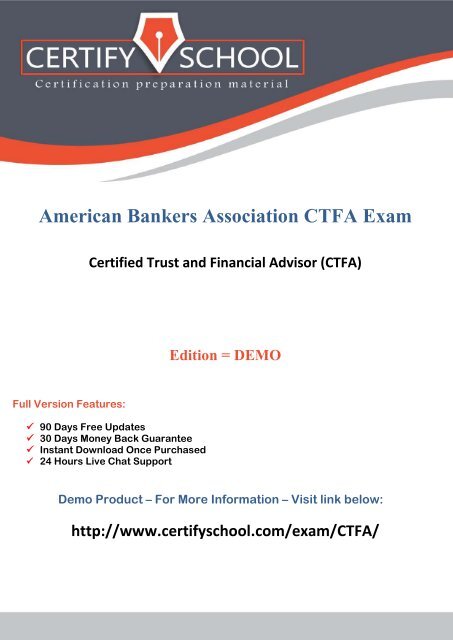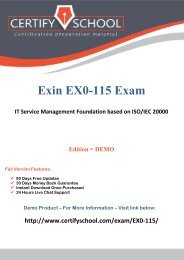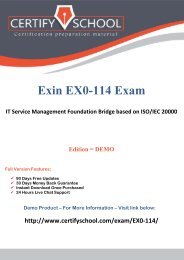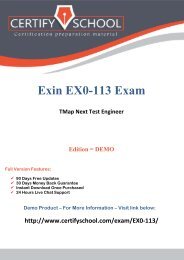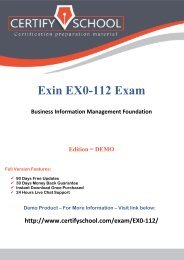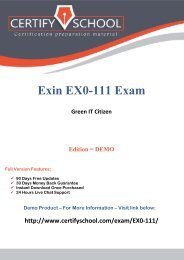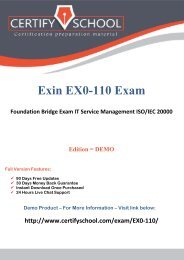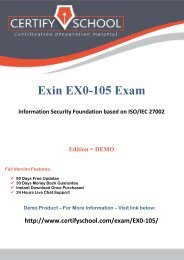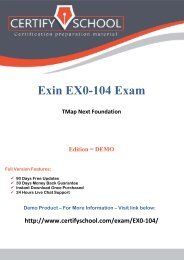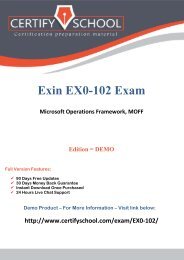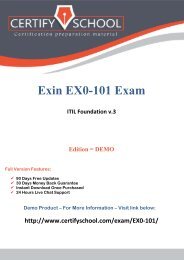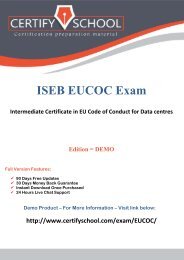CTFA Exam
For more Full product Details:www.CertifySchool.com Our workable study material for exam meets the exact and accurate exam questions and answers. So that’s why CertifySchool is popular in the field of IT Certification Exams material providers.Please visit site: www.certifyschool.com/
For more Full product Details:www.CertifySchool.com
Our workable study material for exam meets the exact and accurate exam questions and answers. So that’s why CertifySchool is popular in the field of IT Certification Exams material providers.Please visit site: www.certifyschool.com/
Create successful ePaper yourself
Turn your PDF publications into a flip-book with our unique Google optimized e-Paper software.
www.CertifySchool.com Certification Preparation Material (PDF)<br />
American Bankers Association <strong>CTFA</strong> <strong>Exam</strong><br />
Certified Trust and Financial Advisor (<strong>CTFA</strong>)<br />
Edition = DEMO<br />
Full Version Features:<br />
90 Days Free Updates<br />
30 Days Money Back Guarantee<br />
Instant Download Once Purchased<br />
24 Hours Live Chat Support<br />
Demo Product – For More Information – Visit link below:<br />
http://www.certifyschool.com/exam/<strong>CTFA</strong>/<br />
http://www.certifyschool.com/exam/<strong>CTFA</strong>/<br />
Page | 1
www.CertifySchool.com Certification Preparation Material (PDF)<br />
Question: 1<br />
Financial goals cove a wide range of financial aspirations such as:<br />
A. Controlling living expenses<br />
B. Meeting retirement needs<br />
C. Setting up a savings and investment program<br />
D. All of the above<br />
Question: 2<br />
Answer: D<br />
These are target dates in the future when certain financial objectives are expected to be completed. What are these<br />
A. Goal dates<br />
B. Target dates<br />
C. Due dates<br />
D. Financial dates<br />
Question: 3<br />
Answer: A<br />
Today’s well-defined employee benefits package cover a full spectrum of benefits that may include all EXCEPT:<br />
A. Long -term care insurance<br />
B. Dental and vision care<br />
C. Subsidized employee benefit plan<br />
D. Partial retirement plans<br />
Question: 4<br />
Answer: D<br />
Tax deferred retirement plans and flexible spending accounts offer tax advantages. Some retirement plans allow you<br />
to__________ against them.<br />
A. Lend<br />
B. Borrow<br />
C. Spend<br />
D. None of the above<br />
Answer: B<br />
http://www.certifyschool.com/exam/<strong>CTFA</strong>/<br />
Page | 2
www.CertifySchool.com Certification Preparation Material (PDF)<br />
Question: 5<br />
Accumulating assets to enjoy in retirement is only part of the:<br />
A. Long-term financial planning process<br />
B. Short-term financial planning process<br />
C. Life time financial planning process<br />
D. Permanent financial planning process<br />
Question: 6<br />
Answer: A<br />
This is a type of employee benefit plan wherein the employer allocates a certain amount of money and then the<br />
employee spends that money for benefits selected from a menu covering everything from child care to health and<br />
life insurance to retirement benefits.<br />
A. Flexible benefit plan<br />
B. Cafeteria plan<br />
C. Short-term financial plan<br />
D. Both of the above are one and the same<br />
Question: 7<br />
Answer: D<br />
Most financial planners fall into one of two categories based on how they are paid. Commission based planners earn<br />
commissions on the financial products they sell, whereas ______________ charge fees based on the complexity of<br />
the plan they prepare.<br />
A. Free only planners<br />
B. Commission based planners<br />
C. Professional planners<br />
D. Security planners<br />
Question: 8<br />
Answer: A<br />
When determining the interaction between the UK and EU on the regulation of the financial services industry, the UK<br />
government must always<br />
A. seek approval from the European Commission before implementing any new regulations.<br />
B. implement new EU Directives by passing acts of Parliament.<br />
C. accommodate all EU Decisions in UK legislation.<br />
D. provide copies of new regulation to the European Commission within a reasonable period of time for their<br />
approval.<br />
http://www.certifyschool.com/exam/<strong>CTFA</strong>/<br />
Page | 3
www.CertifySchool.com Certification Preparation Material (PDF)<br />
Question: 9<br />
Answer: B<br />
A client has previously written to her former adviser opting out of any marketing activities from the firm or any third<br />
parties. However she continues to receive direct investment offers from the firm. She should complain based on the<br />
firm not complying with which set of regulations<br />
A. Conduct of Business rules.<br />
B. Data Protection Act 1998.<br />
C. Distance Selling Regulations.<br />
D. Treating Customers Fairly.<br />
Question: 10<br />
Answer: B<br />
The Financial Services and Markets Act 2000 regulates the provision of which type(s) of financial advice<br />
A. Advice to vulnerable individuals only<br />
B. Advice to all individuals<br />
C. Advice to all individuals and group personal pensions schemes only<br />
D. Advice to all individuals unless they are elective professional clients<br />
Question: 11<br />
Answer: B<br />
Simon has experience of dealing with retail clients and is now in training to qualify as a pension transfer specialist. As<br />
a consequence, which of the following statements are true<br />
A. He must have at least 3 years experience as an adviser before his training can commence<br />
B. His firm is allowed to impose a time limit on completion of the qualification<br />
C. His supervisor must also be suitably qualified<br />
D. Once qualified, CPD requirements are waived for 12 months<br />
E. Once qualified, records of his training must be maintained for at least 5 years<br />
Question: 12<br />
Answer: B, C<br />
The efficient frontier curve shows the optimum balance between:<br />
A. Risk and return<br />
B. Return and taxation<br />
C. Taxation and risk<br />
D. Inflation and return<br />
http://www.certifyschool.com/exam/<strong>CTFA</strong>/<br />
Page | 4
www.CertifySchool.com Certification Preparation Material (PDF)<br />
Question: 13<br />
Answer: A<br />
A UK investor holds a portfolio of overseas equities and is concerned about the exchange rate risk. Which strategy<br />
could he use to mitigate this risk<br />
A. Arbitrage<br />
B. Gearing<br />
C. Hedging<br />
D. Pound cost averaging<br />
Question: 14<br />
Answer: C<br />
When constructing a portfolio for a UK resident basic-rate taxpayer who requires an income, the most tax efficient<br />
solution would be achieved by:<br />
A. Only investing in offshore products<br />
B. Holding fixed-interest funds within a stocks and shares ISA<br />
C. Purchasing National Savings & Investments (NS&I) Fixed-Interest Savings Certificates<br />
D. Holding high-yielding equities within a stocks and shares ISA<br />
Question: 15<br />
Answer: B<br />
The principal reasons for using the Sharpe ratio when calculating a portfolio’s performance are:<br />
A. It indicates the percentage return above/below the risk-free rate for each unit of risk taken<br />
B. It will always be quoted on a rolling quarterly basis<br />
C. A positive Sharpe ratio will always guarantee positive returns<br />
D. The higher the number, the more a portfolio manager can be said to have added value<br />
Question: 16<br />
Answer: A, D<br />
Pauline, a basic-rate taxpayer, has a portfolio which comprises of various equity and fixed-interest unit trusts and<br />
OEICs. She should be aware that:<br />
A. Any losses from this portfolio are allowable for Capital Gains Tax calculations<br />
B. Her entire portfolio will be subject to a 10% tax credit<br />
C. Only the proceeds of sale from the OEICs could be subject to Capital Gains Tax<br />
D. The taxation of dividends on the OEICs held will be treated the same way as the unit trusts<br />
E. She can never reclaim any tax deducted at source<br />
http://www.certifyschool.com/exam/<strong>CTFA</strong>/<br />
Page | 5
www.CertifySchool.com Certification Preparation Material (PDF)<br />
Question: 17<br />
Answer: A, D<br />
Philip took out a qualifying onshore endowment policy for 20 years which he made paidup in year 9. This means that<br />
he may become personally liable to tax on the policy proceeds:<br />
A. At maturity<br />
B. If he makes a partial surrender<br />
C. If he assigns the policy to his wife<br />
D. On settlement of a critical illness claim<br />
Question: 18<br />
Answer: A, B<br />
Bill, a single man, having made full use of his annual gift allowances, made a potentially exempt transfer of £100,000<br />
four and a half years before his death. He has made no other gifts. His residual estate is now valued at £500,000. The<br />
Inheritance Tax liability at death is:<br />
A. £30,000<br />
B. £46,000<br />
C. £94,000<br />
D. £110,000<br />
Question: 19<br />
Answer: D<br />
On Brian’s death, his estate was valued at £820,000. He bequeathed £40,000 to a registered charity and split the<br />
balance equally between his registered civil partner and his brother. Assuming he made no lifetime transfers, what<br />
will the Inheritance Tax liability be<br />
A. £22,750<br />
B. £26,000<br />
C. £29,750<br />
D. £34,000<br />
Question: 20<br />
Answer: B<br />
Trevor is a member of a defined benefit company pension scheme. Which factor relating to his circumstances<br />
confirms that he will avoid incurring a special annual allowance charge in the current tax year<br />
A. He is a member of an Employer Financed Retirement Benefit Scheme (EFRBS)<br />
B. He is aged 61<br />
C. His total annual earnings have never exceeded £110,000<br />
http://www.certifyschool.com/exam/<strong>CTFA</strong>/<br />
Page | 6
www.CertifySchool.com Certification Preparation Material (PDF)<br />
D. His benefits include the maximum level of death benefit<br />
Answer: C<br />
Question: 21<br />
Stephen is about to commence taking benefits from his personal pension scheme, which includes protected rights.<br />
He should be aware that:<br />
A. He can take up to 25% of the total fund as a pension commencement lump sum<br />
B. He has the right to exercise the open market option<br />
C. His whole pension fund must provide limited price indexation in payment<br />
D. The value of the protected rights element will not count towards the lifetime allowance<br />
Question: 22<br />
Answer: A, B<br />
Frank, age 55, is considering adopting a lifestyle investment technique as he aims to build up his personal pension<br />
prior to retirement. He should be aware that:<br />
A. The asset mix of the fund will be adjusted automatically on pre-determined dates<br />
B. His ongoing exposure to equities will reduce with lifestyling<br />
C. After 10 years, a maximum of 25% of the investments will be in bonds<br />
D. Lifestyling is likely to be appropriate if he intends to purchase a conventional annuity with his entire fund.<br />
Question: 23<br />
Answer: A, B, D<br />
Under an employer’s group life assurance policy, what is the normal tax treatment of the death benefit<br />
A. It is liable to Inheritance Tax<br />
B. It is liable to Capital Gains Tax<br />
C. It is liable to Income Tax<br />
D. It is not liable to any form of taxation<br />
Question: 24<br />
Answer: D<br />
If an income protection insurance (PHI) policy has reviewable premiums, this usually means that the insurance<br />
company can:<br />
A. Alter the cost of the cover<br />
B. Withdraw cover on any anniversary date<br />
C. Only increase premiums in line with inflation<br />
D. Pay benefits for less than the full period of incapacity<br />
http://www.certifyschool.com/exam/<strong>CTFA</strong>/<br />
Page | 7
www.CertifySchool.com Certification Preparation Material (PDF)<br />
Question: 25<br />
Answer: A<br />
Apart from comparing cover and costs, what other key factor should usually be considered if a financial adviser<br />
intends to recommend that a client cancels an existing term assurance policy and replaces it with a new one<br />
A. The insurable interest<br />
B. The underwriting requirements<br />
C. The secondhand policy market value<br />
D. The chargeable gains<br />
Answer: B<br />
http://www.certifyschool.com/exam/<strong>CTFA</strong>/<br />
Page | 8
www.CertifySchool.com Certification Preparation Material (PDF)<br />
Demo Product – For More Information – Visit link below:<br />
http://www.certifyschool.com/exam/<strong>CTFA</strong>/<br />
Thanks for Using Our Product<br />
http://www.certifyschool.com/exam/<strong>CTFA</strong>/<br />
Page | 9


